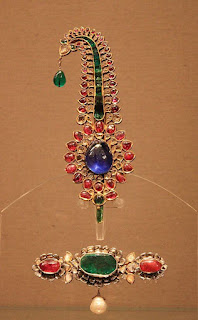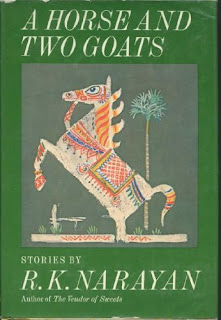R. K. NARAYAN, by Begoña Devis
BIOGRAPHY
R. K. Narayan was an Indian writer born on October
10th, 1906 in Madras (now Chennai), British India, into a Hindu family. He was
one of eight children, six sons and two daughters. His father was a school
headmaster, and Narayan did some of his studies at his father’s school. As his
father’s job entailed frequent transfers, Narayan spent part of childhood under
the care of his maternal grandmother, Pavarti. During this time, his best
friends were a peacock and a mischievous monkey.
When he was twelve years old, Narayan participated in a
pro-independence march, for which he was reprimanded by his uncle, as the
family was apolitical and considered all governments wicked.
Narayan moved to Mysore when his father was transferred
to the Maharajas’s College High School. The well-stocked library at the school,
and his father’s own, fed his reading habit, and he started writing as well.
After completing high school, Narayan failed the university entrance
examination and spent a year at home reading and writing.
After a brief job as a school teacher, Narayan
realized that the only career for him was in writing, and he decided to stay at
home and write novels.
While vacationing at his sister’s house in Coimbatore,
in 1933, Narayan met and fell in love with Rajam, a 15-year-old girl who lived
nearby, and married her. After that, Narayan became a reporter for a Madras
paper called The Justice, dedicated to the rights of non-Brahmins. The job
brought him in contact with a variety of people.
Narayan sent the manuscript of Swami and Friend
(his first novel) to a friend in Oxford, and the friend showed it to Graham
Green, who recommended the book to his publisher, and it was finally published
in 1935.
R. K. Narayan developed his literary career in the
English language and is considered one of the most important Indian
storytellers of the 20th century.
Graham Greene considered himself a friend for life and
decreed success in the Anglo-Saxon world, where Narayan was for a long time,
before Salman Rushdie, perhaps the best-known storyteller of Indian origin.
He wrote about situations in a provincial society in
which shopkeepers, beggars, businessmen and a greedy petty bourgeoisie live
bustling side by side with the old and static world of the peasants and saints.
His novels are set in the imaginary city of Malgudi, especially in the streets
and popular settings, a microcosm of South India that still reflects the values
and customs of the rural and archaic Indian world, but at the same time also the
encounter/disagreement with the modernization that advances inexorably.
However, what stands out in Narayan is his use of
irony, the acute observation of the changes that are taking place, rather than
social or political denunciation. It also highlights how his characters and
their environments continuously refer to the literary and religious heritage of
India (sacred books, traditions and Hindu rites), a heritage that the author
particularly loves and studies. This makes Narayan the singer of a world that,
although not closed to the modern, continues to be deeply proud of its identity
and cultural heritage.
Narayan received various awards and honours, such as
the Padma Bhusham or the Sahita Akademi, India's second and third highest
civilian awards.
R. K. Narayan died on May 13, 2001 in his hometown of
Chennai.
A Horse and Two Goats
This is the history of a misunderstanding between a
poor Indian man, Muni, and a rich American tourist who is visiting the village.
Muni is a very poor man who only has two goats and lives
in a thatched hut. One day, Muni wakes up with the craving for something more
sumptuous than the balls of cooked milled and raw onion he eats for his daily
meal, and asks his wife to make a curry for dinner. She agrees to make him a curry,
provided he can go to the local shop and buy the necessary ingredients for it.
Muni goes to buy them, but the shopkeeper refuses to
allow him to purchase the items on credit, as Muni has no money. Muni returns
home to inform his wife of the bad news. She exasperatedly orders him out of
the house to graze his two goats, which are all he has left of a once large and
healthy herd of sheep and goats that was afflicted by a pestilence.
As Muni walks toward the highway with his two scraggly
goats, he arrives at his favourite spot, an area beside the highway that is the
site of an old and grandiose statue of a warrior and a horse. Suddenly, a
foreigner in a yellow station wagon comes barrelling down the highway, only to
stop abruptly in front of Muni. He reveals that he is interested in buying the
statue from Muni, whom he assumes to be its owner.
They both talk for a long time, but they don't
understand each other at all. Muni explains to the foreigner the miracles and
wonderful deeds carried out by the warrior of the statue, while the American
tells him about his life in New York and what he wants to do with the statue in
his mansion. The foreigner offers him more and more money, thinking that Muni
is haggling, and Muni believes that he wants to buy the goats, so he takes the
money very happily.
After that, the American loads the statue in his
vehicle and drives it away, thinking he has bought it.
Muni returns home triumphant, informing his wife that
he has managed to sell his goats, that had proven to be a curse to him as a
constant reminder of how far he had fallen in the world. His wife initially
assumes that he must have robbed someone, as the sum of 100 rupees is a small
fortune. However, Muni’s elation does not last long as, soon enough, he hears
the bleating of his goats at his door, and his wife threatens to call the
police.
For me, the most interesting thing about the story is
the detailed vision of life in India for poor peasants like Muni, and the huge
difference of cultures that is reflected between that type of life and that of
the foreigner. The sense of humour and irony that there is, transforms a hard
to believe story in a fun and interesting one.
QUESTIONS
Talk about the characters
Muni (age, job, daily routines…)
His wife
The shopman
The postman
The American
Tell us something about the postman’s relationship with Muni. And with the postman.
Say something about Muni’s village.
What kind of conversation do the American and Muni have? What do they talk about?
What do people usually do when they try to communicate to a foreigner?
Once upon a time, offering a cigarette was a way to break the ice to start a conversation. Do you think we now communicate less because we smoke less?
“At seventy-one didn’t run, but surrenders to whatever came.” Do you think there is an age when every one of us has to surrender?
The America got stuck in the Empire State Building’s lift for hours, and then he decided to travel. If you had undergone a big thread in your life, what would you do to make up for it?
What is the American going to do with the statue? How did he carry it?
What kind of souvenirs do you by when you travel?
What is an “avatar”? Do you know something about Hinduism?
What is really communication? Is it always necessary to say something that makes sense?
What did Muni dream to do if he had some money?
What did the American buy, and what did Muni sell?
What happened when Muni arrived home with the money?
VOCABULARY
dotting, bullock,
faggots, millet, pen, tethered, drumstick tree, ails, imp, ledger, swarga, fast,
cronies, hailed, affluence, fleecy, gawky, bhang, thrashed, barren, spurn, scythe,
dhobi, scrounge, cheetah, mauled, Namaste!, gainsay, slanderers, undaunted, wary,
ingratiatingly, backwater, pinioned, Pongal, Parangi, quip, pundit, bearish, lakh,
puja, creeper, gunny sack, dhoti




